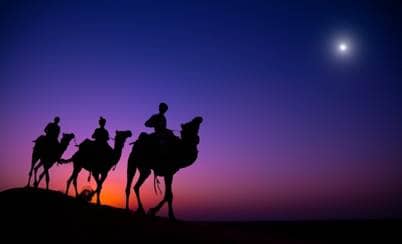
According to The Book of Matthew, the birth of Jesus was marked by a particular celestial event, which we call "The Star of Bethlehem." The Bible itself doesn't give us much detail, but it was that star that enabled the Three Wise Men, or Magi, to locate the Christ Child. Further complicating things is that The Book of Matthew isn't all that distinct about when exactly the Wise Men showed up: there's nothing in the biblical record indicating they showed up that night, and in fact Jesus could have been a toddler by the time they arrived. Nonetheless, we are told that the Wise Men followed "a star." So what were they following?
Here's where we get into an area of controversy for some people: were the Wise Men actually astrologers? Truth be told: we aren't even sure there were three of them, but we can be pretty sure they had some astrological knowledge going for them. Although calling someone a "Wise Man" covers a lot of ground, it would have been pretty much impossible for someone to be considered wise and/or learned if they didn't know their astrology -- there being essentially no distinction at the time between "astrologer" and "astronomer." Without clocks or GPS satellites timing everything back then, keeping track of when to plant crops and how to navigate across the water without landmarks to rely on or how many days until the next Full Moon all involved studying the lights in the sky. Being a "Wise Man" back then without knowing some astrology would be like being a "Wise Man" today and never having heard of the internet: if the last Full Moon was in Taurus then you know that, by around the time of the next Full Moon, the Nile is going to start flooding -- so time your planting and harvesting accordingly. And you'd better watch for the enemy moving his troops at night now, because soon it will be lighter out at night and they know they'll be easier to spot, and so on.
Ancient civilizations relied on the motions of the stars and planets for these things and more. They made other observations too, like how people born when Mars were rising seemed to have a certain temperament, or that a person's life often got difficult as Saturn returned to the same point in the sky as when that person was born. So even though the ancient world may not have used the exact term "science" in the way we do now, they were certainly applying principles of observation. Thus, Wise Men or Magi were also astrologers. The term "Magi" refers specifically to followers of Zoroaster, who came from Persia -- thus, "we have seen his star in the East." The actual term "Magi" doesn't come into play in accounts of the Christ Child until about the 12th Century, so we may be best sticking with the term "Wise Men."
So what was this mysterious "star" that the Wise men followed? There are several candidates:
Halley's Comet was visible in 12 BC, and it's possible that this was the "star" being spoken of. The problem with this notion is that ancient astrologers generally considered comets to be bad news, for the most part, and would hardly be the kind of thing to herald a Messiah. In 3 and 2 BC there was a triple conjunction between Jupiter and the star Regulus. Regulus is the brightest star in the constellation Leo, and a conjunction between the two could well have been taken as a sign that something very "royal" was going on.
Some people have theorized that it may have been a supernova, but supernovas leave remnants, and there do not appear to be any candidates of the right age in our galaxy whose timing coincides with the times we're looking at here. There's always the possibility of what's called a "hypernova" in the Andromeda Galaxy around then... but we don't yet have the instruments to track a nova remnant in another galaxy.
In March and April of 6 BC, the Moon occulted Jupiter twice. This would be no ordinary conjunction: the Moon would have "passed over" Jupiter completely, blocking out view of it entirely. Firmicus Maternus, an astrologer at the time of the Emperor Constantine, claimed that such an event heralded the boith of a "divine and immortal" person. This same event happened on December 7th, 2004 -- so perhaps time will tell if Firmicus Maternus was right.
As an astrologer, my personal favorite is the triple conjunction of Jupiter and Saturn in Pisces in 7 BC: if we are now at "the dawning of The Age Of Aquarius," most astrologers consider the time around the birth of Christ as "the dawning of the Age Of Pisces," and this fits nicely with all the fish symbolism that appears in the New Testament. Jupiter has long been associated with royalty, and Saturn was associated with Baal, the Mesopotamian deity who was long associated with Israel. That, and Jupiter-Saturn aspects have traditionally be associated with larger cycles involving king and kingdoms.
Of course, when you get right down to it, the Star of Bethlehem may have simply been a miracle. I have no problem with that particular explanation, personally. Come to think of it: a child born to a family of modest means while on the road, who couldn't even find proper accommodations... going on to be a symbol of hope and peace for millions? That's the kind of miracle we could use a little more of down here...
To read more by Matt Currie, click here to check out his Beliefnet blog - Oh My Stars.

